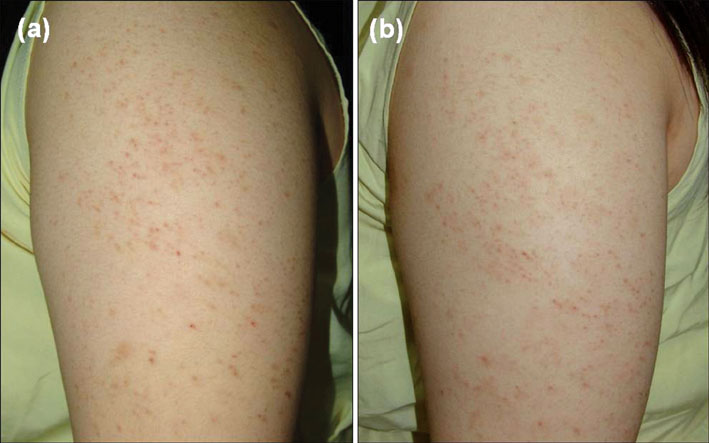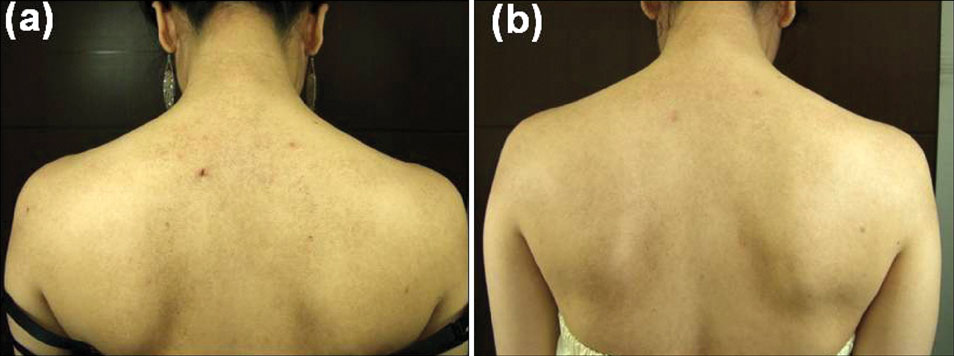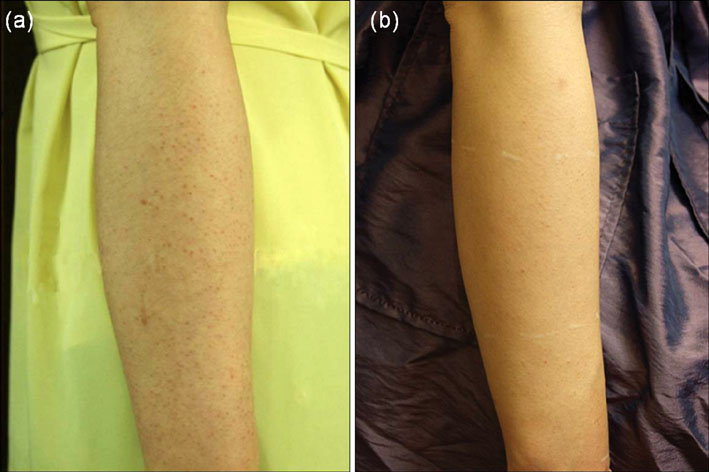Ann Dermatol.
2011 Aug;23(3):293-298. 10.5021/ad.2011.23.3.293.
A Pilot Study of Q-switched 1064-nm Nd:YAG Laser Treatment in the Keratosis Pilaris
- Affiliations
-
- 1Department of Dermatology, Chung-Ang University College of Medicine, Seoul, Korea. beomjoon@unitel.co.kr
- 2Gowoonsesang Skin Clinic, Seoul, Korea.
- KMID: 2171919
- DOI: http://doi.org/10.5021/ad.2011.23.3.293
Abstract
- BACKGROUND
Keratosis pilaris (KP) is a keratinization disorder that is characterized by follicular hyperkeratosis, with surrounding erythema. Topical treatments are widely used, but their effects are limited.
OBJECTIVE
To evaluate the effectiveness of the Q-switched 1064-nm Nd:YAG laser for the treatment of KP.
METHODS
Total of 12 patients with KP were treated with a Q-switched 1064-nm Nd:YAG laser. Ten sessions of laser treatment were delivered once every two weeks. The entire lesions were treated with the following laser settings: 4.0~5.0 J/cm2, 4-mm spot size, and three passes. Two dermatologists' clinical evaluations and patients' satisfaction were assessed between before treatment (baseline) and at 1 month after the last treatment.
RESULTS
Eleven of the twelve patients showed more than grade 2 (>25%) improvement in texture and dyspigmentation in KP lesions, respectively. A half of the patients (50%) showed more than 50% improvement in the skin texture. Regarding dyspigmentation, five patients (41.7%) showed more than 50% improvement. Eleven out of twelve participants were satisfied (>25% of the Patients' self assessment) with the procedure. No significant adverse effect was observed.
CONCLUSION
Although the Q-switched 1064-nm laser treatment may not be the first line therapy for KP, it might be a new treatment option for the patients with recalcitrant KP.
Keyword
MeSH Terms
Figure
Cited by 1 articles
-
A Case of Atrophoderma Vermiculatum Showing a Good Response to Topical Tretinoin
Young Chae Lee, Sook-Ja Son, Tae Young Han, June Hyunkyung Lee
Ann Dermatol. 2018;30(1):116-118. doi: 10.5021/ad.2018.30.1.116.
Reference
-
1. Hwang S, Schwartz RA. Keratosis pilaris: a common follicular hyperkeratosis. Cutis. 2008. 82:177–180.2. Novick NL. Practical management of widespread, atypical keratosis pilaris. J Am Acad Dermatol. 1984. 11:305–306.
Article3. Lateef A, Schwartz RA. Keratosis pilaris. Cutis. 1999. 63:205–207.4. Dawn G, Urcelay M, Patel M, Strong AM. Keratosis rubra pilaris responding to potassium titanyl phosphate laser. Br J Dermatol. 2002. 147:822–824.
Article5. Kaune KM, Haas E, Emmert S, Schön MP, Zutt M. Successful treatment of severe keratosis pilaris rubra with a 595-nm pulsed dye laser. Dermatol Surg. 2009. 35:1592–1595.
Article6. Poskitt L, Wilkinson JD. Natural history of keratosis pilaris. Br J Dermatol. 1994. 130:711–713.
Article7. Clark SM, Mills CM, Lanigan SW. Treatment of keratosis pilaris atrophicans with the pulsed tunable dye laser. J Cutan Laser Ther. 2000. 2:151–156.
Article8. Alcántara González J, Boixeda P, Truchuelo Díez MT, Fleta Asín B. Keratosis pilaris rubra and keratosis pilaris atrophicans faciei treated with pulsed dye laser: report of 10 cases. J Eur Acad Dermatol Venereol. 2011. 25:710–714.
Article9. Cho SB, Lee JH, Lee SH, Lee SJ, Bang D, Oh SH. Efficacy and safety of 1064-nm Q-switched Nd:YAG laser with low fluence for keloids and hypertrophic scars. J Eur Acad Dermatol Venereol. 2010. 24:1070–1074.
Article10. Chung WK, Yang JH, Lee DW, Chang SE, Lee MW, Choi JH, et al. Paradoxical darkening of unperceived tattoo ink after relatively low fluence from a Q-switched Nd:YAG (1064-nm) laser in the course of treatment for melasma. Clin Exp Dermatol. 2009. 34:e555–e557.
Article11. Sardana K, Relhan V, Garg V, Khurana N. An observational analysis of erythromelanosis follicularis faciei et colli. Clin Exp Dermatol. 2008. 33:333–336.
Article12. Augustine M, Jayaseelan E. Erythromelanosis follicularis faciei et colli: relationship with keratosis pilaris. Indian J Dermatol Venereol Leprol. 2008. 74:47–49.
Article13. Kim MG, Hong SJ, Son SJ, Song HJ, Kim IH, Oh CH, et al. Quantitative histopathologic findings of erythromelanosis follicularis faciei et colli. J Cutan Pathol. 2001. 28:160–164.
Article
- Full Text Links
- Actions
-
Cited
- CITED
-
- Close
- Share
- Similar articles
-
- Comparison of Wound Repair after Irradiation of Rat Skin with 1064 nm Nd:YAG, CO2, and Er:YAG Lasers
- Hypopigmentation Induced by Frequent Low-Fluence, Large-Spot-Size QS Nd:YAG Laser Treatments
- The Therapeutic Effects of the Q-Switched Nd:YAG Laser on Pigmented Lesions
- Photodynamic Therapy Combined with 1064-nm Nd:YAG Laser Therapy and Topical Efinaconazole for Refractory Onychomycosis: Case Series
- Efficacy and Safety of 1,064 nm Q-switched Nd:YAG Laser Treatment for Removing Melanocytic Nevi





